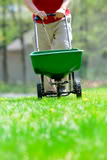Fertilizing Your Lawn: What You Need to Know

Applying a fertilizer 4-5 times a year is the most ideal schedule for achieving a beautiful and healthy lawn. But there are so many questions that surround fertilizing your lawn: when to start, how much fertilizer, what type and more. Here you will find some basic information to help take the confusion out of fertilizing your lawn. If you feel more comfortable leaving the fertilizing to the professionals, then make it easy on yourself and find a reliable landscaping professional to help you out.
What is Fertilizer?
Fertilizer is a mix of elements intended for helping your grass grow to its fullest. The three elements in most fertilizers are: nitrogen, phosphorus and potassium. Most fertilizers on the market today contain all three of these elements and are known as complete fertilizers. These three element are represented on each bag of fertilizer by numbers such as 12-6-6. These numbers correspond to the levels of each element in this order: nitrogen, phosphorus, potassium.
Should You Go Organic?
There are other types of fertilizers on the market today that effectively fertilize grass. One of these formulations is organic fertilizer, which often consists of compost. During the spring and fall it is recommended to spread the compost over the lawn; it will work by crowding the weeds out and away from the grass and its roots.
Determining the Right Fertilizer for Your Lawn
Use this helpful fertilizer calculator to help you determine the amount of fertilizer needed for your yard.
Step 1: Have Your Soil Tested
Having your soil tested by a professional landscaper or fertilizing company will help determine if there are any specific problems with your grass that need to be addressed through fertilization. A soil test will also tell you what specific types of nutrients your lawn needs in order to develop healthy and lush green grass.
Step 2: Determine Grass Type
Grass type plays a very important role in determining what type of fertilizer to use, when to apply it and how much of it to apply. A landscaping professional can also help you determine your grass type.
Step 3: What Type of Fertilizer?
There are four main types of fertilizers: granular (dry) fertilizers, liquid fertilizers, synthetic fertilizers and organic fertilizers.
- Granular fertilizers are the most popular and come in large 20-50 pound bags. As mentioned above, this type of fertilizer has the 3-element number representation system on its bags.
- Liquid fertilizers are commonly used by attaching a hose to a small container filled with fertilizer and spraying the combination on the lawn. The fertilizer in the bottle or container is in concentrated liquid form, and it must have the power of the hose nozzle, along with the water, to work.
- Synthetic fertilizers are known for their fast-acting greening effect on lawns. As a result of being chemically based, the lawns will look good from synthetic fertilizing but they won't receive the nutrients needed.
- Organic fertilizers are totally natural and some believe that they are the best way to achieve the healthiest possible lawn. Organic fertilizers are often applied over the lawn using shovels, rakes, special spreaders or hands and are also known for improving the texture and surface of the lawn.
Be aware that fertilizing can stimulate too much top growth at the expense of root growth. Over-fertilizing in a single application can also burn leaf tissue. With this in mind, make sure to read the label of your fertilizer and to follow any safety precautions noted for you and your family (such as how long to stay off of the grass after it has been fertilized).
Looking for a Pro? Call us (866) 441-6648

Landscaping Average Costs
Landscapers Experiences

Hiring A Great Landscaper Was Almost Too Easy, Even Long Distance

Fast Professional Tree Service For My Crabapple And Persimmon



